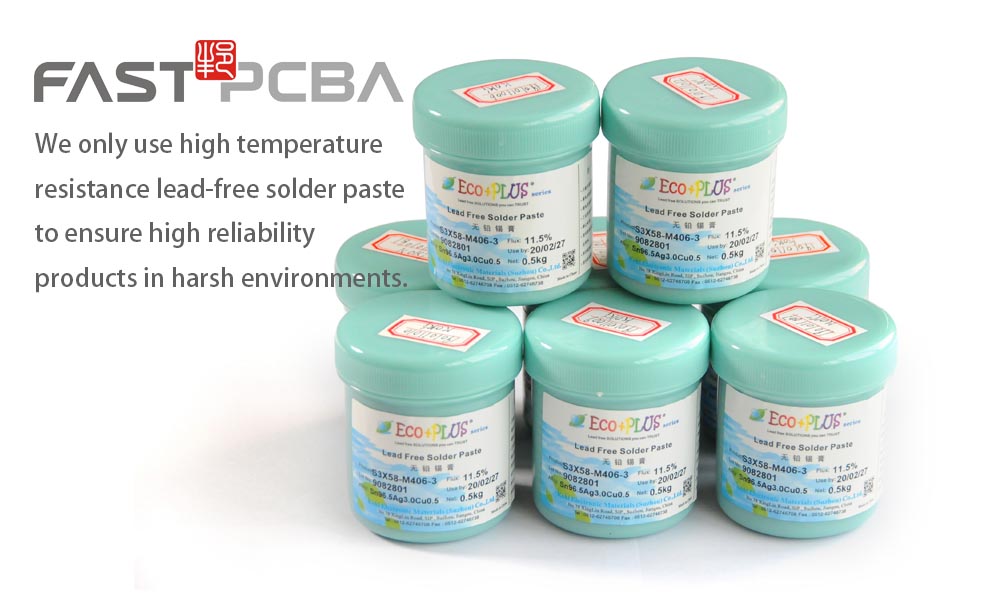About us
FASTPCBA Co.,Ltd
-
 Building 1, Senyang Electronic Technology Park, Guangming High-tech Park, Yutang Street, Guangming District, Shenzhen City.
Building 1, Senyang Electronic Technology Park, Guangming High-tech Park, Yutang Street, Guangming District, Shenzhen City.
-
 F:86-13418481618
F:86-13418481618
-
 [email protected]
[email protected]
 date:2019-11-28 16:27:49
date:2019-11-28 16:27:49
Solder Paste Collapse Cause Analysis
Collapse is divided into cold collapse and hot collapse. Cold collapse refers to the collapse behavior that occurs at room temperature. After printing, the solder paste gradually diffuses under the surrounding environmental conditions, and the solder paste coating gradually changes from a well-shaped brick to a smooth dome shape.

Thermal collapse refers to the collapse that occurs during the reflow stage. Strictly speaking, it is not a printing problem, but a problem related to solder paste performance.
The causes of cold collapse are:
A. Low thixotropy; B. Low viscosity; C. Low metal or solid content; D. Small particle size: E. The particle size distribution is too wide; F. Low surface tension of the flux; G. High humidity; H. Hygroscopic solder paste; G. High component placement pressure. For thermal collapse, in addition to the reasons discussed above, it is also affected by the heating rate of the reflow curve. The collapse is because the viscosity of the solder paste is not high enough to resist the collapse force applied by gravity, so the diffusion exceeds the coated area.
2. For cold collapse, the metal content has only a slight positive effect on reducing collapse. For thermal collapse (such as at 100 ° C), no short circuit was seen at 91% and 92% metal content, but below 90% metal content, the effect of thermal collapse increased rapidly with the decrease in metal content. The low slump rate of high metal content solder paste can be attributed to the high viscosity, because the metal particles cannot flow before melting. In addition to the effect of metal content, slump generally decreases with increasing flux solids content. Fluxes with a high solid content not only exhibit high viscosity at room temperature but also at increase temperatures, so they have greater resistance to collapse. The solder paste particle size and distribution also affect the collapse. Because the solder powder is in a solid state at room temperature and 100 ℃, and the flux is melted at 100 ℃, it can be seen in the test at 100 ℃ that the flux becomes thinner and causes a larger collapse. The effect of flux liquefaction is offset by the increase in paste viscosity due to the reduced particle size. The result is that the slump decreases with decreasing particle size, especially at 100 ° C. It was also found that the wide particle size distribution worsened the collapse at both temperatures than the narrow particle size distribution. During heating, the flux between the particles melts and is used as a lubricant to allow the particles to slide through and collapse. The probability of particle-to-particle contact is high, there is more resistance to sliding, and less collapse will occur. The high collapse index is probably related to the wide PSD, which can be attributed to the better powder filling, which reduces the probability of contact between particles.
The surface tension of the flux is another important factor affecting the collapse. Higher surface tension fluxes tend to reduce their surface area and therefore have greater resistance to prevent diffusion and collapse. The high surface tension of the flux at room temperature not only reduces the collapse of the solder paste, but also reduces the diffusion amount of molten solder.
The solder paste can absorb a large amount of moisture, resulting in low viscosity and collapse. This is especially true for many water-soluble, relatively hygroscopic solder pastes. For most solder pastes, a relative humidity of 30% -50% is appropriate.
High component placement pressure squeezes the solder paste, thus exacerbating the collapse behavior. However, strictly speaking, solder paste extrusion does not belong to the category of collapse.
Collapse can also be affected by the rate of heating during reflow. In general, the viscosity of materials with fixed composition and chemical structure decreases with increasing temperature, which is due to the increase of molecular-level thermal agitation. A decrease in viscosity at higher temperatures will cause greater collapse. On the other hand, an increase in temperature usually dehydrates more flux solvents, leading to an increase in solids content and therefore increased viscosity
The thermal stirring effect is a property of the internal matter, it is only a function of temperature and has nothing to do with time, so the heating rate has no effect on it. The solvent vaporization rate is directly proportional to the thermal energy or temperature of the solvent. The amount of solvent loss is proportional to the product of vaporization rate and vaporization time. In other words, the total solvent loss is a function of both time and temperature, so it can be adjusted by changing the reflow heating rate. For a slow heating rate, the solder viscosity is higher than that of a fast heating rate at any given elevated temperature due to a large amount of solvent loss.
Therefore, by applying a relatively slow heating rate, the solvent loss effect can be enhanced and it exceeds the thermal stirring effect, which will cause the viscosity to decrease, or the pure viscosity will increase with increasing temperature, so the collapse will decrease as the heating rate decreases.
Collapse is the main feature of solder paste materials, and most solutions to reduce collapse are in the design of the material. In terms of process, controlling humidity and heating rate are both effective ways to reduce this problem.
 Building 1, Senyang Electronic Technology Park, Guangming High-tech Park, Yutang Street, Guangming District, Shenzhen City.
Building 1, Senyang Electronic Technology Park, Guangming High-tech Park, Yutang Street, Guangming District, Shenzhen City.
 F:86-13418481618
F:86-13418481618
 [email protected]
[email protected]